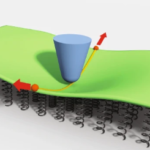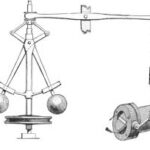In this method, equilibrium of the forces acting on the link BD are considered. The instantaneous centre I lies at the point of intersection of PB produced and a line through D perpendicular to the spindle axis, as shown in Fig. 6.4. Taking moments about the point I,

Fig. 6.4.

Practise Problems:
(2.) Porter governor has equal arms each 250 mm long and pivoted on the axis of rotation. Each ball has a mass of 5 kg and the mass of the central load on the sleeve is 25 kg. The radius of rotation of the ball is 150 mm when the governor begins to lift and 200 mm when the governor is at maximum speed. Find the minimum and maximum speeds and range of speed of the governor.
Solution:
Given: BP = BD = 250 mm = 0.25 m ; m = 5 kg ; M = 15 kg ; r1 = 150 mm= 0.15m; r2 = 200 mm = 0.2 m

Fig. 6.5.
The minimum and maximum positions of the governor are shown in Fig. 6.5 (a) and (b) respectively.
Minimum speed when r1 = BG = 0.15 m
Let N1 = Minimum speed.
 From Fig. 6.5 (a), we find that height of the governor,
From Fig. 6.5 (a), we find that height of the governor,
N1 = 133.8 r.p.m.
Maximum speed when r2 = BG = 0.2 m
Let N2 = Maximum speed.
From Fig. 6.5 (b), we find that height of the governor,

N2 = 154.5 r.p.m.
We know that range of speed = N2 – N1 = 154.4 – 133.8 = 20.7 r.p.m.
(3.) The arms of a Porter governor are each 250 mm long and pivoted on the governor axis. The mass of each ball is 5 kg and the mass of the central sleeve is 30 kg. The radius of rotation of the balls is 150 mm when the sleeve begins to rise and reaches a value of 200 mm for maximum speed. Determine the speed range of the governor. If the friction at the sleeve is equivalent of 20 N of load at the sleeve, determine how the speed range is modified.
Solution:
Given : BP = BD = 250 mm ; m = 5 kg ; M = 30 kg ; r1 = 150 mm ; r2 = 200 mm
First of all, let us find the minimum and maximum speed of the governor. The minimum and maximum position of the governor is shown in Fig. 6.6 (a) and (b) respectively.
Let N1 = Minimum speed when r1 = BG = 150 mm, and N2 = Maximum speed when r2 = BG = 200 mm.

Fig. 6.6.
Speed range of the governor
From Fig. 6.6 (a), we find that height of the governor,

We know that

N1 = 177 r.p.m.
From Fig. 6.6 (b), we find that height of the governor,


N2 = 204.4 r.p.m.
We know that speed range of the governor = N2 – N1 = 204.4 – 177 = 27.4 r.p.m.
Speed range when friction at the sleeve is equivalent of 20 N of load (i.e. when F = 20 N)
We know that when the sleeve moves downwards, the friction force (F) acts upwards and the minimum speed is given by

N1 = 172 r.p.m.
We also know that when the sleeve moves upwards, the frictional force (F) acts downwards and the maximum speed is given by

N2 = 210 r.p.m.
We know that speed range of the governor = N2 – N1 = 210 – 172 = 38 r.p.m.
(4.) A Porter governor has all four arms 250 mm long. The upper arms are attached on the axis of rotation and the lower arms are attached to the sleeve at a distance of 30 mm from the axis. The mass of each ball is 5 kg and the sleeve has a mass of 50 kg. The extreme radii of rotation are 150 mm and 200 mm. Determine the range of speed of the governor.
Solution: Given : BP = BD = 250 mm ; DH = 30 mm ; m = 5 kg ; M = 50 kg ; r1 = 150 mm ; r2 = 200 mmFirst of all, let us find the minimum and maximum speed of the governor. The minimum and maximum position of the governor is shown in Fig. 6.8 (a) and (b) respectively.

Fig. 6.8.
Let N1 = Minimum speed when r1 = BG = 150 mm ; and
N2 = Maximum speed when r2 = BG = 200 mm.
From Fig. 18.8 (a), we find that height of the governor,

From Fig. 6.8(b), we find that height of the governor,

We know that range of speed = N2 – N1 = 238 – 208 = 30 r.p.m.


